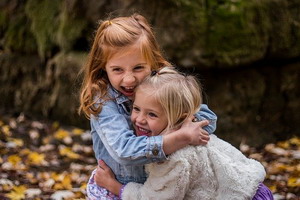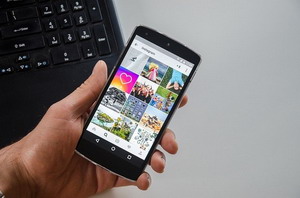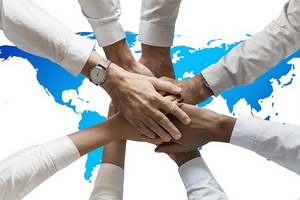 We live to connect. Connection is one of the fundamental purposes of conscious existence. Connection creates both purpose and meaning in life. Imagine being stranded alone on a desert island with no hope of ever being rescued. Initially, you scramble around just trying to survive, but once you get a survival routine established, you begin to question why you are trying so hard to stay alive. Without anyone else around, what is the point of surviving? Nothing we do matters. Our existence serves no purpose. Once we are gone, it will be as though we never existed.
We live to connect. Connection is one of the fundamental purposes of conscious existence. Connection creates both purpose and meaning in life. Imagine being stranded alone on a desert island with no hope of ever being rescued. Initially, you scramble around just trying to survive, but once you get a survival routine established, you begin to question why you are trying so hard to stay alive. Without anyone else around, what is the point of surviving? Nothing we do matters. Our existence serves no purpose. Once we are gone, it will be as though we never existed.
 Connection begins with the awareness of something more than ourselves. Until this happens we are just playing with self-generated fantasies with which we amuse ourselves in our loneliness and separation. But we are terrified of connection because everyone and everything outside of us is different from us. It is not us. It/they do not put our needs and wants first and foremost. We are not the most important nor the point of their existence. In fact, it seems most of the time that they are barely aware that we even exist. How can we survive and be safe without our needs and wants being of paramount importance to ‘them’? This may sound crazy, but this is exactly what a tiny baby feels. For many people, this is still how they feel just under the surface.
Connection begins with the awareness of something more than ourselves. Until this happens we are just playing with self-generated fantasies with which we amuse ourselves in our loneliness and separation. But we are terrified of connection because everyone and everything outside of us is different from us. It is not us. It/they do not put our needs and wants first and foremost. We are not the most important nor the point of their existence. In fact, it seems most of the time that they are barely aware that we even exist. How can we survive and be safe without our needs and wants being of paramount importance to ‘them’? This may sound crazy, but this is exactly what a tiny baby feels. For many people, this is still how they feel just under the surface.
 Answering this question begins the process of growing up. Growing up is primarily the process of learning how to successfully connect and participate with others in a harmonious manner. One of the first steps we make is figuring out that we are not all that different from everyone else. Our needs and wants are the same as the needs and wants of everyone else. We all need safety from immediate harm, food, water, air, protection from the elements, and the hope for meeting these needs in the future. This commonality we have with all other living beings creates a bond of belonging due to the awareness of a common vulnerability. This belonging provides the opportunity for mutually supportive participation in getting these needs met. Diversity improves our odds of compensating or overcoming our vulnerability. For instance, we all have to sleep – a time of great vulnerability. Through mutual harmonious participation, we can provide each other protection during times of sleep. The challenge is to create trust and this is supported by creating a feeling of belonging.
Answering this question begins the process of growing up. Growing up is primarily the process of learning how to successfully connect and participate with others in a harmonious manner. One of the first steps we make is figuring out that we are not all that different from everyone else. Our needs and wants are the same as the needs and wants of everyone else. We all need safety from immediate harm, food, water, air, protection from the elements, and the hope for meeting these needs in the future. This commonality we have with all other living beings creates a bond of belonging due to the awareness of a common vulnerability. This belonging provides the opportunity for mutually supportive participation in getting these needs met. Diversity improves our odds of compensating or overcoming our vulnerability. For instance, we all have to sleep – a time of great vulnerability. Through mutual harmonious participation, we can provide each other protection during times of sleep. The challenge is to create trust and this is supported by creating a feeling of belonging.
 This presents us with the basic question for this newsletter – how do we create connections? Many people seem to be born with social intelligence that allows them to connect easily at any time and any place. But there are a huge number of people that don’t have those genes. A recent statistic that relates here is how many people do you call friends? This question has been asked by sociologists for many years in all sorts of large group surveys. Back in the ’70s and ’80s the average answer was 3 to 5 good friends that you talked to and socialized with regularly. For couples the same number applied, 3 to 5 other couples you socialized with. When this same question was asked a few years ago (pre covid) that number had dropped down to 0 to 1 for both individuals and couples. There has been a significant drop in socialization over the last 30 to 40 years. Most people and couples are alone or have only one friend at best.
This presents us with the basic question for this newsletter – how do we create connections? Many people seem to be born with social intelligence that allows them to connect easily at any time and any place. But there are a huge number of people that don’t have those genes. A recent statistic that relates here is how many people do you call friends? This question has been asked by sociologists for many years in all sorts of large group surveys. Back in the ’70s and ’80s the average answer was 3 to 5 good friends that you talked to and socialized with regularly. For couples the same number applied, 3 to 5 other couples you socialized with. When this same question was asked a few years ago (pre covid) that number had dropped down to 0 to 1 for both individuals and couples. There has been a significant drop in socialization over the last 30 to 40 years. Most people and couples are alone or have only one friend at best.
 When researchers write about why this might be, the answers usually come down to our personal participation with our increased technology. Back in the day entertainment was derived from group gatherings, from large groups such as attending dances, concerts, and movies, to the small family group all gathered around the single-family television. Swimming pools were public as no one had private pools, and many people still used public transportation as most families had only one car. Carpooling was a real thing back then. These days people are much more inclined to spend a significant amount of the day on their cellphone or computer interacting with social media which is anything but actually social. People stream their video entertainment to their personal devices rather than having to share a single screen with many others and negotiate what will be watched. I remember every night TV started with the evening news for an hour and a half because that is what my parents wanted to watch. I spent my time alone with my personal media device, a book.
When researchers write about why this might be, the answers usually come down to our personal participation with our increased technology. Back in the day entertainment was derived from group gatherings, from large groups such as attending dances, concerts, and movies, to the small family group all gathered around the single-family television. Swimming pools were public as no one had private pools, and many people still used public transportation as most families had only one car. Carpooling was a real thing back then. These days people are much more inclined to spend a significant amount of the day on their cellphone or computer interacting with social media which is anything but actually social. People stream their video entertainment to their personal devices rather than having to share a single screen with many others and negotiate what will be watched. I remember every night TV started with the evening news for an hour and a half because that is what my parents wanted to watch. I spent my time alone with my personal media device, a book.
 The consequence of this lack of socialization is a growing distrust between people. You learn to trust by participating with people. You develop a history of seeing how they act and react to many sorts of situations. You come to have some sort of understanding of how they think and feel based on this personal history. Without that bank account of personal experience, folks default to expectations about how they think others should behave, not understand why a person is acting the way they are. There is no sense of invested connection that prompts a person to even try to see things through another person’s eyes; walk in their shoes. Instead, we jump to judgment and complaint because those around us don’t think and feel the way we think they should. This is separation, not connection. We have created that desert island to live on without having to be shipwrecked. We manufacture our lonesomeness simply by failing to connect. We are seeing the natural consequence of that aloneness now. Depression is at an all-time high. Pills for anxiety and every other mental illness are handed out like candy. We are losing our purpose in being alive. Even something as basic as finding a mate has lost ground. I have heard from several patients that young people they know don’t date and are not planning on having a mate relationship. They feel it is just too much work. That sounds like the next generation of kids will mostly be accidents and raised by a single parent, assuming there is a next generation. Birth rates are falling all over the globe. Many countries have already fallen below the birth rate necessary to simply replace the current people.
The consequence of this lack of socialization is a growing distrust between people. You learn to trust by participating with people. You develop a history of seeing how they act and react to many sorts of situations. You come to have some sort of understanding of how they think and feel based on this personal history. Without that bank account of personal experience, folks default to expectations about how they think others should behave, not understand why a person is acting the way they are. There is no sense of invested connection that prompts a person to even try to see things through another person’s eyes; walk in their shoes. Instead, we jump to judgment and complaint because those around us don’t think and feel the way we think they should. This is separation, not connection. We have created that desert island to live on without having to be shipwrecked. We manufacture our lonesomeness simply by failing to connect. We are seeing the natural consequence of that aloneness now. Depression is at an all-time high. Pills for anxiety and every other mental illness are handed out like candy. We are losing our purpose in being alive. Even something as basic as finding a mate has lost ground. I have heard from several patients that young people they know don’t date and are not planning on having a mate relationship. They feel it is just too much work. That sounds like the next generation of kids will mostly be accidents and raised by a single parent, assuming there is a next generation. Birth rates are falling all over the globe. Many countries have already fallen below the birth rate necessary to simply replace the current people.
 So what is the answer? The answer is connection of course! But connection involves communicating our feelings. Feeling connected is a feeling event. Trust comes from feeling and in time knowing how others feel about things. You don’t get trust from sharing interests. You don’t trust someone simply because they say they share your beliefs. Trust comes from experiencing their actions, and action tells us about their feelings. Action flows from our inner feelings and desires. Once we get a sense of whether we can trust someone, we can open dialogue and communicate our desires and feelings to look for opportunities to create mutually supportive engagements. This is scary to do because as soon as we open our mouths and express our feelings, we risk being judged. If we have any connection to reality at all, we understand that everyone is different. Even though we all have common needs and vulnerabilities, we all have very different histories in which we developed different skills and beliefs about how to get our needs met. Inherently we believe our way is the right and best way since we can only directly experience our way. Consequently, we tend to judge any way that is different from our own.
So what is the answer? The answer is connection of course! But connection involves communicating our feelings. Feeling connected is a feeling event. Trust comes from feeling and in time knowing how others feel about things. You don’t get trust from sharing interests. You don’t trust someone simply because they say they share your beliefs. Trust comes from experiencing their actions, and action tells us about their feelings. Action flows from our inner feelings and desires. Once we get a sense of whether we can trust someone, we can open dialogue and communicate our desires and feelings to look for opportunities to create mutually supportive engagements. This is scary to do because as soon as we open our mouths and express our feelings, we risk being judged. If we have any connection to reality at all, we understand that everyone is different. Even though we all have common needs and vulnerabilities, we all have very different histories in which we developed different skills and beliefs about how to get our needs met. Inherently we believe our way is the right and best way since we can only directly experience our way. Consequently, we tend to judge any way that is different from our own.
 If you are intelligent, you will get it that of course, no one will actually see things exactly your way. They can’t. They can only see life from their own perspective. With sufficient motivation they can try to imagine your view of the world, but they can’t feel it without the common experiences that world view creates. If someone appears to see things exactly like you, then they are using a parroting technique they learned to get you to like them and serve them. Once you embrace reality as it is, then judgments lose their personal meaning and are instead understood as expressions of what the judging person feels, fears, and believes. It really has nothing to do with you.
If you are intelligent, you will get it that of course, no one will actually see things exactly your way. They can’t. They can only see life from their own perspective. With sufficient motivation they can try to imagine your view of the world, but they can’t feel it without the common experiences that world view creates. If someone appears to see things exactly like you, then they are using a parroting technique they learned to get you to like them and serve them. Once you embrace reality as it is, then judgments lose their personal meaning and are instead understood as expressions of what the judging person feels, fears, and believes. It really has nothing to do with you.
 Sharing your feeling-self and receiving their feeling-self is the essential skill that opens the door to connection. Common beliefs, attitudes, and life experiences make sharing more comfortable and serve as a supportive environment for risking sharing those deeper feelings. Sometimes they will be well received and other times they won’t. The different outcomes are what guide us in choosing who we want to hang out with. We need to know what feelings drive the behaviors of those we participate with because then we can guess fairly accurately how they will act. We can always trust that each person will act in accordance with who they are on the inside. That is the real trust we can have.
Sharing your feeling-self and receiving their feeling-self is the essential skill that opens the door to connection. Common beliefs, attitudes, and life experiences make sharing more comfortable and serve as a supportive environment for risking sharing those deeper feelings. Sometimes they will be well received and other times they won’t. The different outcomes are what guide us in choosing who we want to hang out with. We need to know what feelings drive the behaviors of those we participate with because then we can guess fairly accurately how they will act. We can always trust that each person will act in accordance with who they are on the inside. That is the real trust we can have.
Take care,
David
